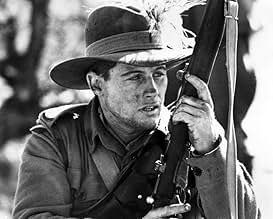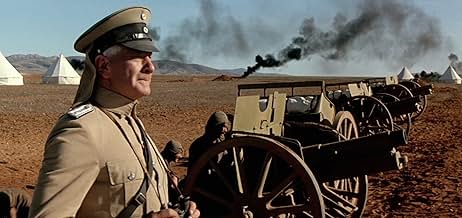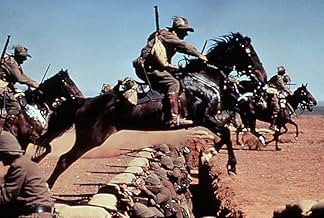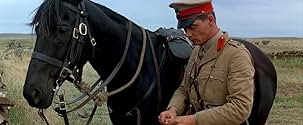CALIFICACIÓN DE IMDb
6.8/10
2.2 k
TU CALIFICACIÓN
En 1917, cuando las fuerzas británicas están empantanadas frente a las líneas turcas y alemanas en Palestina, confían en el regimiento australiano de caballos ligeros para salir del atollade... Leer todoEn 1917, cuando las fuerzas británicas están empantanadas frente a las líneas turcas y alemanas en Palestina, confían en el regimiento australiano de caballos ligeros para salir del atolladero.En 1917, cuando las fuerzas británicas están empantanadas frente a las líneas turcas y alemanas en Palestina, confían en el regimiento australiano de caballos ligeros para salir del atolladero.
- Dirección
- Guionista
- Elenco
- Premios
- 2 premios ganados y 1 nominación en total
Jack Heywood
- Dave's Dad
- (as John Heywood)
- Dirección
- Guionista
- Todo el elenco y el equipo
- Producción, taquilla y más en IMDbPro
Opiniones destacadas
I saw only the last half of this one, appropriately enough on Anzac Day, tuning in just as the delicious Nurse Siggy Thornton is writing a love letter that intelligence Major Anthony Andrews is going to mislead Johnny Turk with. So I missed the alleged tedium of the first hour. The film is no doubt best viewed on a big screen, but what I did see in the last hour was the Australian Light Horse attack on Beersheba, brilliantly staged and filmed, with hundreds of horses and extras and tonnes of dramatic tension.
The actual battle was an Aussie military success, due in large part to their opponents, especially the Germans, underestimating them. It was a change from Gallipoli, where some of the horsemen had fought a couple of years earlier. It was terribly thoughtful of the Australian commanders to order the attack an hour before sunset when the light is best, and Dean Semler the cinemaphotographer takes full advantage of it. The close camera shots in the battle really give you the feeling you're right in it - there is nothing particularly original about "Saving Private Ryan" made 10 years later.
Yes, it's a cliché-ridden and chauvinistic script. The real villains are the Germans, all from Central Casting's Nazi division, despite this being a movie about the FIRST World War, but the British officers are also portrayed as pretty perfidious - the guys who made snobbery an art form to cover their incompetence. The Turks, though, are shown as brave and worthy opponents, if a little under the Germans' thumb. No doubt John Ford would have done it differently (I'm not sure he would have handled the horses any better) but this is the Australian point of view. A Turkish version would be interesting.
Anyway, worth it for the final battle.
The actual battle was an Aussie military success, due in large part to their opponents, especially the Germans, underestimating them. It was a change from Gallipoli, where some of the horsemen had fought a couple of years earlier. It was terribly thoughtful of the Australian commanders to order the attack an hour before sunset when the light is best, and Dean Semler the cinemaphotographer takes full advantage of it. The close camera shots in the battle really give you the feeling you're right in it - there is nothing particularly original about "Saving Private Ryan" made 10 years later.
Yes, it's a cliché-ridden and chauvinistic script. The real villains are the Germans, all from Central Casting's Nazi division, despite this being a movie about the FIRST World War, but the British officers are also portrayed as pretty perfidious - the guys who made snobbery an art form to cover their incompetence. The Turks, though, are shown as brave and worthy opponents, if a little under the Germans' thumb. No doubt John Ford would have done it differently (I'm not sure he would have handled the horses any better) but this is the Australian point of view. A Turkish version would be interesting.
Anyway, worth it for the final battle.
A First World War Australian cavalry -- sorry, mounted infantry -- film set in the Holy Land, that's not something one tends to see every day. So, for me, the fact that, yes, the characters and situations can be a little clichéd at times is far outweighed by the novelty of the whole scenario. Quibbles are easy to put to one side.
The cavalry distinction is important. Cavalry would be armed with carbines and sabres. Mounted infantry have rifles and dismount in order to fight. This subtlety plays a part in the outcome.
A series of small skirmishes heightens tension within the film until the exciting finale, when there is a fantastic, large scale, cav ... mounted infantry charge which got my pulse racing. You'll recall something similar in David Lean's "Lawrence of Arabia". This set piece is bigger. Johnny Turk was the villain that time too.
This being an Australian Imperial Force meets the British Army sort of film, there is bound to be a little Pommy-bashing going 'round. When I lived briefly in Australia a decade ago, I found Pommy-bashing to be the single unattractive facet to the Australian national character. (The Kiwis don't do it. We like Poms here too. Pity the Dominions can't agree on that one.) So while some of the Poms in this film might be a few sheep short of a paddock, still there *is* balance, with one Pom who is much cleverer than the average. Bashing even works its way into the plot, a nice touch that.
The film does not use an excessive amount of Strine lingo -- billy, tucker -- so very little acclimatization is necessary for the uninitiated.
I can't vouch for the overall authenticity of this film. But I did notice that campaign map in the Turkish commander's office. It's labelled in Arabic only. Egypt is identified as "Misr". Geez, that is the correct Arabic name. And the Ottomans were still using the Arabic alphabet at the time. (It's Atatürk after the war who switched Turkish over to the Roman alphabet.) The thing's fair dinkum, mate. If they cared enough to get details like that right, then I'm sure that says a lot about the effort put into the film as a whole.
There is an earlier Australian film about the Light Horse I'd like to see, "Forty Thousand Horsemen" from 1940 or '41 (sources differ). Finding a copy of that film in this hemisphere though would be extraordinary, a bit like finding a North American who likes Vegemite.
The cavalry distinction is important. Cavalry would be armed with carbines and sabres. Mounted infantry have rifles and dismount in order to fight. This subtlety plays a part in the outcome.
A series of small skirmishes heightens tension within the film until the exciting finale, when there is a fantastic, large scale, cav ... mounted infantry charge which got my pulse racing. You'll recall something similar in David Lean's "Lawrence of Arabia". This set piece is bigger. Johnny Turk was the villain that time too.
This being an Australian Imperial Force meets the British Army sort of film, there is bound to be a little Pommy-bashing going 'round. When I lived briefly in Australia a decade ago, I found Pommy-bashing to be the single unattractive facet to the Australian national character. (The Kiwis don't do it. We like Poms here too. Pity the Dominions can't agree on that one.) So while some of the Poms in this film might be a few sheep short of a paddock, still there *is* balance, with one Pom who is much cleverer than the average. Bashing even works its way into the plot, a nice touch that.
The film does not use an excessive amount of Strine lingo -- billy, tucker -- so very little acclimatization is necessary for the uninitiated.
I can't vouch for the overall authenticity of this film. But I did notice that campaign map in the Turkish commander's office. It's labelled in Arabic only. Egypt is identified as "Misr". Geez, that is the correct Arabic name. And the Ottomans were still using the Arabic alphabet at the time. (It's Atatürk after the war who switched Turkish over to the Roman alphabet.) The thing's fair dinkum, mate. If they cared enough to get details like that right, then I'm sure that says a lot about the effort put into the film as a whole.
There is an earlier Australian film about the Light Horse I'd like to see, "Forty Thousand Horsemen" from 1940 or '41 (sources differ). Finding a copy of that film in this hemisphere though would be extraordinary, a bit like finding a North American who likes Vegemite.
This is an excellent film with surely the finest cavalry charge ever filmed. In this movie the horse is King and the care taken to illustrate the vital interaction between these magnificent animals and their riders is great to behold. The acting and direction are good without the need for big names. It has had a number of releases, the best being a 2.35 wide screen laser disc version in the USA. Australia has released a DVD version but it is dreadfully truncated being cut to 1.78 from the vastly more meaningful aspect ratio of the laser disc. On the big screen this film makes a fantastic impact and every effort should be made to see the original wide screen version in this way. Highly recommended.
This is a story about some episode British-Turk campaign in Palestine in 1917. Very important role in this campaign was played by Australian forces. The key to conquer the Holy Land is city of Gaza. British general wants however to throw his forces to bypass the city and capture another one - Beersheba. To take them both it is necessary to keep his plan secret.
As a person who is interested in all WWI history I was waiting for this movie. I find it very good. All equipment seems to be very accurate, however, I've never heard about use of tanks in this front. There is a nice scene of air attack by German biplane, cars from that times, uniforms, and so on -- it all seems to be historical correct. The final charge is worth waiting for. I think that anyone who is interested in this campaign would be satisfied.
Because of Australian point of view the role of British army seems to be a little underrated. I especially mean British commander -- general Allenby. I think it would be good to say at the very end that after capturing Beersheba, Gaza fell as well a week later, and the road to Jerusalem was opened. This was what was lacking for me.
As a person who is interested in all WWI history I was waiting for this movie. I find it very good. All equipment seems to be very accurate, however, I've never heard about use of tanks in this front. There is a nice scene of air attack by German biplane, cars from that times, uniforms, and so on -- it all seems to be historical correct. The final charge is worth waiting for. I think that anyone who is interested in this campaign would be satisfied.
Because of Australian point of view the role of British army seems to be a little underrated. I especially mean British commander -- general Allenby. I think it would be good to say at the very end that after capturing Beersheba, Gaza fell as well a week later, and the road to Jerusalem was opened. This was what was lacking for me.
Despite the ubiquitous appearance by Sigrid Thorton, and my having to eat crow over my previous comments on Anthony Andrew's acting ability (no scenery chewing or hamming it up here), I very much enjoyed this outstanding Aussie film.
Simon Wincer has directed a wide variety of films, some bad (like the Cheryl Ladd waste of celluloid "Bluegrass" and the turkey "Pharlap") and some very good (like the intense "Harlequin" and the great A&E mini "PT Barnum"). I find this one to be particularly special due to it containing one of the best war sequences on film.
Wincer and his crew have excellently interwoven a beautifully done drama with incredible special effects. The battle sequence at the end if the film is so powerful that even seen on video on an average size home TV it is astounding. Not only is the Lighthorsemen's assault wonderfully choreographed, but the reaction shots of the cast are well performed. You can see the private struggles going on in the face of the big one.
This is not a movie for the faint of heart nor should it be dismissed as just another war movie by those a little leery of the genre.
Simon Wincer has directed a wide variety of films, some bad (like the Cheryl Ladd waste of celluloid "Bluegrass" and the turkey "Pharlap") and some very good (like the intense "Harlequin" and the great A&E mini "PT Barnum"). I find this one to be particularly special due to it containing one of the best war sequences on film.
Wincer and his crew have excellently interwoven a beautifully done drama with incredible special effects. The battle sequence at the end if the film is so powerful that even seen on video on an average size home TV it is astounding. Not only is the Lighthorsemen's assault wonderfully choreographed, but the reaction shots of the cast are well performed. You can see the private struggles going on in the face of the big one.
This is not a movie for the faint of heart nor should it be dismissed as just another war movie by those a little leery of the genre.
¿Sabías que…?
- TriviaWebsite Cinephilia reports of the Jon Blake accident and legal case: "Jon Blake was critically injured whilst driving home on December 1, 1986, after the final day's filming of The Lighthorsemen (1987). He sustained severe brain injuries and in December, 1995, the New South Wales Supreme Court ruled that Blake should be compensated for the loss of potential earnings as a star in the United States. After taking evidence from actors, directors, and film critics who indicated his career could have been as big as Mel Gibson's, the court awarded him $32 million in damages. This was later reduced to $7 million after the defence appealed."
- ErroresAt the rest camp just after the 2 soldiers pass the British Major and addresses the Colonel about the men wearing shorts at the end the Colonel calls the Major 'Sir', this wouldn't happen as a Colonel is a higher rank to Major.
- Versiones alternativasUK versions are cut by 6 secs to remove cruel horsefalls.
- ConexionesEdited into The Young Indiana Jones Chronicles: Palestine, October 1917 (1993)
- Bandas sonorasAUSTRALIA WILL BE THERE
Music and lyrics by W.W. 'Skipper' Francis
By Arrangement with Allans Music (Australia) Pty. Limited
Selecciones populares
Inicia sesión para calificar y agrega a la lista de videos para obtener recomendaciones personalizadas
- How long is The Lighthorsemen?Con tecnología de Alexa
Detalles
- Fecha de lanzamiento
- País de origen
- Sitios oficiales
- Idioma
- También se conoce como
- The Light Horse Men
- Locaciones de filmación
- St. Kilda, Melbourne, Victoria, Australia(beach, Mediterranean Sea)
- Productoras
- Ver más créditos de la compañía en IMDbPro
Taquilla
- Presupuesto
- AUD 10,500,000 (estimado)
- Total en EE. UU. y Canadá
- USD 33,779
- Fin de semana de estreno en EE. UU. y Canadá
- USD 23,645
- 10 abr 1988
- Total a nivel mundial
- USD 34,514
- Tiempo de ejecución
- 2h 11min(131 min)
- Mezcla de sonido
- Relación de aspecto
- 2.35 : 1
Contribuir a esta página
Sugiere una edición o agrega el contenido que falta




























